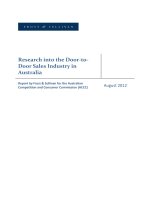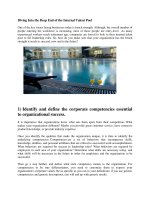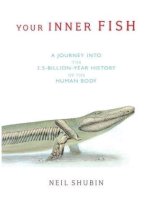Carl gustav jung AION researches into the phenomenology of the self (1959)
Bạn đang xem bản rút gọn của tài liệu. Xem và tải ngay bản đầy đủ của tài liệu tại đây (256 KB, 372 trang )
o oooi
1 1
132 J95co v.9
pt.2
C.
G.
(carl
187 5-1961. en
works.
1S95
The
Mithraic god Aion
Roman, and-jrd century
AION
RESEARCHES INTO THE
PHENOMENOLOGY OF THE
C. G.
SELF
JUNG
TRANSLATED BY
R. F, C.
HULL
BOLLINGEN SERIES XX
PANTHEON BOOKS
COPYRIGHT
1959 BY BOLLINGEN FOUNDATION
INC.,
NEW
YORK, N. Y.
PUBLISHED FOR BOLLINGEN FOUNDATION INC.
BY PANTHEON BOOKS
THIS EDITION
IS
INC.,
NEW
YORK,
N. Y.
BEING PUBLISHED IN THE
UNITED STATES OF AMERICA FOR THE BOL-
LINGEN FOUNDATION BY PANTHEON BOOKS
INC., AND IN ENGLAND BY ROUTLEDGE AND
KEGAN PAUL, LTD. IN THE AMERICAN EDITION, ALL THE VOLUMES COMPRISING THE
COLLECTED WORKS CONSTITUTE NUMBER
XX IN BOLLINGEN SERIES, THE PRESENT
VOLUME IS NUMBER 9 OF THE COLLECTED
WORKS, AND IS THE EIGHTH TO APPEAR.
IT
IS
IN
TWO
PARTS,
PUBLISHED
RATELY, THIS BEING PART
SEPA-
II.
Translated from the
first part of Aion:
Untersuchungen zur Symbolgeschichte
(Psychologische Abhandlungen, VIII), published by Rascher Verlag, Zurich, 1951.
LIBRARY OF CONGRESS CATALOG CARD NUMBER: 52-8757
IN THE UNITED STATES OF AMERICA BY H. WOLFF
MANUFACTURED
NEW
YORK, N.
Y.
r,'
J
EDITORIAL NOTE
Volume
g of the Collected
Works
Is
devoted to studies of the
specific archetypes of the collective unconscious. Part
The Archetypes and
the Collective Unconscious.,
I,
entitled
composed of
a long monograph on the archeis
shorter essays; Part II, Aion, is
type of the self. The author has agreed to a modification of the
sub-title of Aion, which in the Swiss edition appeared in two
forms, ''Researches into the History of Symbols" and "Contributions to the Symbolism of the Self." The first five chapters were
previously published, with small differences, in Psyche and Symbol: A Selection 'from the Writings of C. G. Jung} edited by
Violet S. de Laszlo (Anchor Books, Garden City, New York,
1958).
TRANSLATOR'S NOTE
Grateful acknowledgment is made to the following persons,
translations have been consulted during the preparation
of the present work: Mr. William H. Kennedy, for reference to
whose
and 3, issued as
"Shadow, Animus, and Anima" by the Analytical Psychology
Club of New York, 1950; Dr. Hildegarde Nagel, for reference
to her translation of the original Eranos-Jahrbuch version (1949)
of "Concerning the Self," in Spring, 1951, which original version the author later expanded into Aion, chapters 4 and 5; and
Miss Barbara Hannah and Dr. Marie-Louise von Franz, for
helpful advice with the remaining chapters. Especial thanks are
due to Mr. A. S. B. Glover, who (unless otherwise noted) translated the Latin and Greek texts throughout. References to pubhis translation of portions of Aion., chapters 2
lished sources are given for the sake of completeness.
V,
TABLE OF CONTENTS
EDITORIAL NOTE
LIST
V
OF PLATES
viii
FOREWORD
I.
II.
III.
TV.
ix
The Ego
The Shadow
The Syzygy: Anima and Animus
The Self
3
8
1 1
23
V. Christ, a Symbol o the Self
VI. The Sign of the Fishes
36
72
The Prophecies of Nostradamus
VIII. The Historical Significance of the Fish
IX. The Ambivalence of the Fish Symbol
X. The Fish in Alchemy
VII.
i.
The Medusa,
Symbol
XI.
The
126
2.
The
Fish, 137
3.
95
103
118
126
The Fish
of the Catharists, 145
Alchemical Interpretation of the Fish
XII. Background to the Psychology of Christian
Alchemical Symbolism
XIII. Gnostic Symbols of the Self
XIV. The Structure and Dynamics of the Self
XV. Conclusion
154
*73
184
222
266
BIBLIOGRAPHY
27 1
3 O1
INDEX
vli
LIST OF PLATES
The
MIthralc god Aion
Roman, snd-grd
century.
Museo Profano, Vatican.
P: Alinari.
frontispiece
I.
The Four Elements
Michael Maier, Scrutinium chymicum (1687),
Emblema XVII,
p. 49.
following page
II.
The
From
#50
Trinity
a manuscript by Joachim of Flora. Graphics Collection, Zurich
Central Library,
Bx
606,
following page
V11I
254
FOREWORD
The theme
of this
work *
Is
the idea of the
Aeon
(Greek,
A ion).
with the help of Christian, Gnostic, and
alchemical symbols of the self, to throw light on the change of
psychic situation within the "Christian aeon." Christian tradition from the outset is not only saturated with Persian and
Jewish ideas about the beginning and end of time, but is filled
with intimations of a kind of enantiodromian reversal of domi-
My investigation seeks,
mean by
this the dilemma of Christ and Antichrist.
of
the
most
historical speculations about time and the
Probably
limitation of time were influenced, as the Apocalypse shows, by
nants. I
is therefore only natural that my reflections
should gravitate mainly round the symbol of the Fishes^ for the
Pisces aeon is the synchronistic concomitant of two thousand
years of Christian development. In this time-period not only
was the figure of the Anthropos (the "Son of Man ') progres-
astrological ideas. It
1
and thus assimilated psychologichanges in man's attitude that had
sively amplified symbolically,
cally,
but
it
brought with
it
already been anticipated by the expectation of the Antichrist
in the ancient texts. Because these texts relegate the appearance
of Antichrist to the end of time, we are justified in speaking o
a "Christian aeon/' which, it was presupposed, would find its
end with the Second Coming. It seems as if this expectation
coincides with the astrological conception of the "Platonic
month" of the Fishes.
[In the Swiss edition, this foreword begins as follows: "In this volume (VIII of
the Psychologische Abhandlungen) I am bringing out two works which, despite
their inner and outer differences, belong together in so far as they both treat
of the great theme of this book, namely the idea of the Aeon (Greek, Aion).
While the contribution of my co-worker, Dr. Marie-Louise von Franz, describes
the psychological transition from antiquity to Christianity by analysing the Passion of St. Perpetua, my own investigation seeks, with the help of* etc., as above.
Dr. von Franz's "Die Passio Perpetuae" is omitted from the present volume.
i
EDITORS.]
ix
FOREWORD
occasion for my proposing to discuss these
historical questions is the fact that the archetypal image of
wholeness, which appears so frequently in the products of the
unconscious, has its forerunners in history. These were Identified very early with the figure of Christ, as I have shown in my
book Psychology and Alchemy (chapter 5). I have been rethe relations between
quested so often by my readers to discuss
the traditional Christ-figure and the natural symbols of whole-
The immediate
ness that I finally decided to take this task in hand. Considering
decision did
the unusual difficulties of such an undertaking,
not come easily to me, for, in order to surmount all the ob-
my
stacles and possibilities of error, a knowledge and caution would
be needed which, unfortunately, are vouchsafed me only in
limited degree. I am moderately certain of my observations on
the empirical material, but I am fully aware of the risk I am
of
taking in drawing the testimonies of history into the scope
I am takthe
know
also
think
I
I
reflections.
responsibility
my
ing upon myself when, as though continuing the historical
process of assimilation, I add to the many symbolical amplifications of the Christ-figure yet another, the psychological one, or
even, so it might seem, reduce the Christ-symbol to a psycho-
reader should never forget, howlogical image of wholeness.
o faith or writing a
a
confession
that
am
not
I
ever,
making
My
tendentious tract, but am simply considering how certain
things could be understood from the standpoint of our modern
consciousness things which I deem it valuable to understand,
and which are obviously in danger of being swallowed up in the
and oblivion; things, finally, whose
would
much
do
to remedy our philosophic clisunderstanding
orientation by shedding light on the psychic background and
the secret chambers of the soul. The essence of this book was
abyss of incomprehension
up gradually, in the course of many years, in countless
conversations with people of all ages and all walks of life; with
people who in the confusion and uprootedness of our society
were likely to lose all contact with the meaning o European
culture and to fall Into that state of suggestibility which Is the
occasion and cause of the Utopian mass-psychoses of our time.
I write as a physician, with a physician's sense of responsibility, and not as a proselyte. Nor do I write as a scholar,
otherwise I would wisely barricade myself behind the safe walls
built
x
FOREWORD
my specialism and not, on account of my inadequate knowledge of history, expose myself to critical attack and damage my
scientific reputation. So far as my capacities allow, restricted as
they are by old age and illness, I have made every effort to document my material as reliably as possible and to assist the verio
fication of
my
conclusions by citing the sources.
C. G.
May 1950
XI
JUNG
AION
RESEARCHES INTO THE PHENOMENOLOGY
OF THE SELF
These things came
might be made the
to pass, they say, that Jesus
first sacrifice
in the discrim-
ination of composite natures.
HIPPOLYTUS., ElenchoSj VII, 27, 8
THE EGO
Investigation of the psychology of the unconscious confronted me with facts which required the formulation of new
concepts. One of these concepts is the self. The entity so denoted
is not meant to take the
place of the one that has always been
known as the ego, but includes it in a supraordinate concept.
understand the ego as the complex factor to which all conscious contents are related. It forms, as it were, the centre of the
field of consciousness; and, in so far as this comprises the empirical personality, the ego is the subject of all personal acts of
consciousness. The relation of a psychic content to the ego forms
the criterion of its consciousness, for no content can be conscious unless it is represented to a subject.
With this definition we have described and delimited the
scope of the subject. Theoretically, no limits can be set to the
field of consciousness, since it is capable of indefinite extension.
We
Empirically, however, it always finds its limit when it comes up
against the unknown. This consists of everything we do not
know, which, therefore, is not related to the ego as the centre
of the field of consciousness. The unknown falls into two groups
of objects: those which are outside and can be experienced by
the senses, and those which are inside and are experienced immediately. The first group comprises the unknown in the outer
call this
world; the second the unknown in the inner world.
latter territory the unconscious.
The ego, as a specific content of consciousness, is not a simple or elementary factor but a complex one which, as such,
cannot be described exhaustively. Experience shows that it rests
on two seemingly different bases: the somatic and the psychic,
The somatic basis is inferred from the totality of endosomatic
perceptions, which for their part are already of a psychic nature
and are associated with the ego, and are therefore conscious.
They are produced by endosomatic stimuli, only some of which
We
3
AION
cross the threshold o
consciousness.
A
considerable proportion
of these stimuli occur unconsciously, that is, subliminally. The
fact that they are subliminal does not necessarily mean that their
merely physiological, any more than this would be true
of a psychic content. Sometimes they are capable of crossing the
status
is
threshold, that is, of becoming perceptions. But there is no
doubt that a large proportion of these endosomatic stimuli are
simply incapable of consciousness and are so elementary that
there is no reason to assign them a psychic natureunless of
course one favours the philosophical view that all life-processes
are psychic anyway.
strable hypothesis
is
The
that
chief objection to this hardly demonit enlarges the concept of the psyche
bounds and interprets the life-process in a way not
absolutely warranted by the facts. Concepts that are too broad
beyond
all
usually prove to be unsuitable instruments because they are too
vague and nebulous. I have therefore suggested that the term
"psychic" be used only where there is evidence of a will capable
of modifying reflex or instinctual processes. Here I must refer
my paper "On the Nature of the Psyche," l where
the reader to
I
have discussed this definition of the "psychic" at somewhat
greater length.
The somatic basis of the ego consists, then, of conscious and
unconscious factors. The same is true of the psychic basis: on
the one hand the ego rests on the total field of consciousness,
and on the other, on the sum total of unconscious contents.
These fall into three groups: first, temporarily subliminal contents that can be reproduced voluntarily (memory); second,
unconscious contents that cannot be reproduced voluntarily;
third, contents that are not capable of becoming conscious at all.
Group two can be inferred from the spontaneous irruption of
subliminal contents into consciousness. Group three is hypothetical; it is a logical inference from the facts underlying group
two. This contains contents which have not yet irrupted into
consciousness, or which never will.
When 1 said that the ego *'rests" on the total field of consciousness I do not mean that it consists of this. Were that so, it
would be indistinguishable from the field of consciousness as a
whole. The ego is only the latter's point of reference, grounded
on and limited by the somatic factor described above,
1 1
954/55 version:
"The
Spirit of Psychology."
4
THE EGO
;
bases are in themselves relatively unknown and
the
unconscious,
ego is a conscious factor par excellence. It is
even acquired, empirically speaking, during the individual's
lifetime. It seems to arise in the first place from the collision
between the somatic factor and the environment, and, once
established as a subject, it goes on developing from further col-
Although
its
with the outer world and the inner.
Despite the unlimited extent of its bases, the ego is never
more and never less than consciousness as a whole. As a conscious factor the ego could, theoretically at least, be described
completely. But this would never amount to more than a piclisions
ture of the conscious personality; all those features which are
or unconscious to the subject would be missing.
A
unknown
total picture
would have
to Include these.
But
a total descrip-
tion of the personality is, even in theory, absolutely impossible,
because the unconscious portion of it cannot be grasped cognitively. This unconscious portion, as experience has abundantly
is by no means
unimportant. On the contrary, the most
decisive qualities in a person are often unconscious and can be
perceived only by others, or have to be laboriously discovered
shown,
with outside help.
Clearly, then, the personality as a total phenomenon does
not coincide with the ego, that is, with the conscious personality,
but forms an entity that has to be distinguished from the ego.
Naturally the need to do this is incumbent only on a psychology
that reckons with the fact of the unconscious, but for such a
psychology the distinction is of paramount importance. Even for
jurisprudence it should be of some importance whether certain
psychic facts are conscious or not for instance, in adjudging the
question of responsibility.
I have suggested calling the total personality which, though
present, cannot be fully known, the self. The ego is, by definition, subordinate to the self and is related to it like a part to the
whole, Inside the field of consciousness it has, as we say, free
will. By this I do not mean anything philosophical, only the
well-known psychological fact of "free choice/' or rather the subclashes with
jective feeling of freedom. But, just as our free will
necessity in the outside world, so also it finds its limits outside
the field of consciousness in the subjective inner world, where
it comes into conflict with the facts of the self. And just as
5









